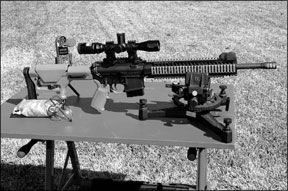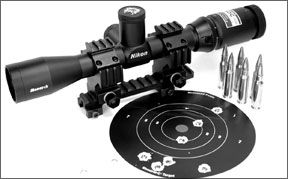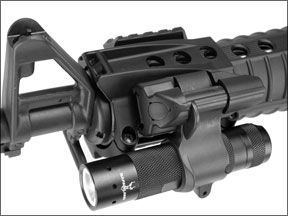The AR-15 platform is booming not only in total unit sales but also in aftermarket accessories such as buttstocks, hand guards, sights, you name it. Perhaps even more significant is the availability of ARs chambered for calibers other than .223 Remington-the greatest indication that shooters like something is that theyre willing to tinker with it.
In this test we will evaluate three such carbines with 16-inch barrels chambered for 6.8mm SPC ammunition. All three of these models were flat-top designs featuring a Picatinny rail atop the receiver. They were the $1114 DPMS AP4 Panther Carbine that came with a $124 JP Enterprises trigger upgrade; the $925 RRA LAR-6.8 Mid-Length A4 from Rock River Arms, and a left hand (left-side ejection) 5L from Stag Arms. The base price of a Stag Arms 5L was $1095, but our Stag was customized with several options that added nearly $1000 to the retail list price.

Would these features give the Stag an unfair advantage when compared to the Rock River and DPMS products? We think the answer is no, and here is why. Given the modular design of the basic platform, every feature found on the customized Stag 5L could also be applied to our other test samples as well as any other AR, carbine or rifle. Therefore, we felt that we would be able to isolate the benefit of a given modification and render judgment on the basic weapon. For example, if the compensator on the Stag were to help us get better hits, we still might prefer one of the other carbines but recommend the application of said compensator.
The 6.8 SPC presents a bullet that is about 0.27 inches in diameter typically weighing 110 to 115 grains. The difference in overall cartridge size between 6.8 SPC and .223 Remington ammunition does not appear to be major. But 6.8 SPC magazines of the same length as 30-round .223 magazines hold five rounds fewer. Our test ammunition was Remingtons 115-grain Express Rifle OTM and two rounds from Hornady Manufacturing. They were the 110-grain V-Max Varmint Express and 115-grain BTHP/WC Custom loads.
Our first encounter with a 6.8 SPC carbine was reported in the November 2008 issue of Gun Tests. This was Rugers handy Mini 14. Now we had a chance to see if this caliber was better suited to the AR-15. We began our tests by mounting a Nikon Monarch 2-8X32mm BDC scope No. 8438. This was a 1-inch-tube scope with four circles below the crosshairs for instant holdover. We liked the Monarchs range of power and its clear field of vision. We could have chosen this same model with the Nikoplex reticle instead of the BDC circles for $10 less, (catalog number 8437), but we were curious to see if the reticle really worked. We mounted the scope utilizing a Yankee Hill Machine scope riser and a pair of B-Square Tactical Tri-rings ($74 from brownells.com). We think the addition of Nikon target turrets enhanced function as well as visual appeal. For collecting accuracy data from the 100-yard line we traveled west from downtown Houston to American Shooting Centers located in George Bush Park (amshootcenters.com). Our first step was to zero each carbine at the 50-yard bench. We blended in a break-in regimen of cleaning the barrel every five shots for the first 25 rounds. A fouling shot was fired after each cleaning. Then we moved to the 100-yard line to readjust our point of impact and record the width of five-shot groups, measuring the holes widest apart from center to center. We also planned a 200-yard firing session utilizing the first holdover circle and a rapid-fire test. Here is what we learned.
Rock River Arms RRA
LAR-6.8 Mid-Length
A4 SPC1238X
6.8 SPC, $925
Regardless of caliber most ARs look alike. The six-position butt stock with integral sling loop, the black aluminum receiver, the plastic grip with faux checkering and a single finger groove, the rigid front sight housing with sling loop and bayonet lug were typical. These characteristics were shared with the DPMS carbine as well. But our Rock River was distinguished by a full-diameter barrel, and the even-numbered slots in the rail stretching across the receiver were bright and clear. Aside from its clean detail, the Rock River impressed us with the way its 6.7 pounds of weight were well spent in building a sturdy weapon.
The trigger on our Rock River was listed as being a two-stage match design. The first stage seemed to present little or no resistance. The final stage was clean and precise, making it difficult to judge the amount of pressure needed to break the shot. But our Chatillon trigger scale read about 6.5 pounds every time we measured it.
When we first received this carbine the bolt was very difficult to pull back. We can recall testing custom pistols wherein the gunsmith told us with pride that the slide was going to be very tight and hard to move at first. But were not so sure this is a good thing in an AR. Several times during our tests the Rock River failed to eject the spent case. Perhaps the meshing of the bolt lugs with the chamber lugs was impeded. The round could have been positioned to fire but the extractor may not have gone forward enough to grip the case rim. Other possibilities were that the extractor was too tight or the bolt was not free to move the necessary distance or at the proper speed.
Double feeds were another problem. More than once a round had not completely entered the chamber with another round trying to exit the magazine at the same time. In other events a spent case was in the way of the fresh round already released from the top of the magazine. We do not think the magazine was at fault because we shared every magazine supplied by our three manufacturers without change of condition.
The Rock River SPC1238X came with a limited lifetime warranty. Since we were sure these problems would be covered under such warranty and we could avoid feeding problems by loading one shot at a time, we continued with our tests. Among our choices of test ammunition, only the 110-grain Hornady BTHP/WC ammunition produced an average group size of less than 2.0 inches. This was below our expectation. Despite its quality trigger, perhaps it was the distraction and frustration caused by the malfunctions that interfered with our shooting.
Given these malfunctions, we disqualified this gun from our 200-yard exercise and of course, the rapid-fire drills.
DPMS AP4 Panther Carbine
6.8 SPC, $1114
If it seems that everyone wants a flat-top AR, there are still more than a few operators who prefer a carry handle. Our DPMS offered the best of both worlds. With the removable carry handle in place, the shooter was treated to a fully adjustable sight picture from a choice of two different size apertures. The rear sight was secure and well protected. With its carry handle removed, the 4-ounce difference in weight between our Rock River and DPMS carbines was reflected visually only in the reduction of the outer diameter of the Panthers barrel some 4 inches from the muzzle. Otherwise, they appeared nearly identical. But in terms of feel, the two weapons were very different. The DPMS felt noticeably lighter, expressing a balance point closer to the middle of the receiver.
The next difference was the trigger. Installed was the JP Enterprises single-stage trigger, which is available as an option on most of the DPMS products. The base price of the model RFA2-AP468 was $989.

It took us only a handful of shots to zero the Nikon Monarch BDC scope at 50 yards. About five shots into our 100-yard bench session the DPMS carbine doubled. This meant that a single trigger press produced two shots. Had there been more rounds in the magazine perhaps more would have been fired unintentionally. Thankfully, the towering berms that back the targets at ASC and the firm hold of our shooter kept the rounds from leaving the range. We inspected the trigger group as per the recommendation of the printed material supplied by the manufacturer. We found the components to be clean and free of any debris that might sabotage the trigger. The directions advised that doubling was possible if the trigger was improperly installed or adjusted below 3 pounds. We weighed trigger resistance to be no lower than 4.5 pounds. We did not disassemble the trigger system, but we could feel that some of the interacting surfaces were sharp to the touch. Yet, no burrs could be detected. At this point we reloaded, chambering one round and leaving just one more in the magazine. This time the gun did not double. However, nor did it cycle properly. From this point on, the trigger would not reset even after tossing out the spent case and chambering the next round.
Once again we were faced with ceasing our test. The next day we chose to re-inspect the trigger assembly and try again. With no change in condition we decided to complete our test of the DPMS loading and firing one shot at time. Naturally, this malfunction disqualified the DPMS from rapid-fire tests. We also decided to forgo the 200-yard session and limit our tests to collecting data from the 100-yard bench.
Results were similar to the groups we printed with the Rock River Arms carbine. Only one of our test rounds was able to produce an average five-shot group measuring less than 2 inches across. The 110-grain Hornady V-Max was the preference of this carbine. Assuming our single-shot usage was not a detriment to our shooting, we feel the accuracy of this carbine was below what our testers expected.
Stag Arms 5L 6.8 SPC, $1989
As previously mentioned, the “as tested” label represents a significant list of upgrades from the basic model 5L. Beginning at $1081, the final price also reflected a $95 “discount” for not applying the standard sights. But here are the features we added. A full-length Samson Star R Rifle length Quad Rail for $310; The $255 Magpul PRS Precision Rifle Stock, Magpul MIAD Pistol Grip with enhanced trigger guard, $46, and a $15 CR123A Battery Core; Midwest Industries Front Flip-up Sight MCTAR-FFR, $90, and a Same Plane Low Profile Flip-up Sight MCTAR-SPLP for $130. Also added were Ladder rail protectors, $50, an $85 Tango-Down Quick Detach Vertical Grip BGV-QDITI, and Stags own compensator, the $8 StagComp. We found the low price of the compensator hard to believe, and called Stag to double check. Yes, $8 was correct.
Before evaluating each upgrade, here is how the Stag Arms 5L performed from the bench. The Stag 5L was the only carbine to produce sub-2-inch groups with all three choices of ammunition. The best performer was the 115-grain Remington ammunition, which also helped us print the only sub-minute-of-angle group of the test 0.9 inches. Actually, we are sure we could have done better if it werent for two problems. First, the DPMS and Rock River were tested during ideal weather conditions. The Stag Arms carbine was tested in swirling winds under overcast skies that varied from dim to tunnel like. We should add that the Nikon scope helped by catching more light than we thought possible under the conditions.
Ranking the optional equipment, the long quad rail helped us stabilize the carbine on the sandbags. The rail was heavily vented. This kept the barrel a little cooler but also exposed the shooter to the escaping heat. The rail covers protected our hands from the edges of the Picatinny rails, and they stayed in place. There are plenty of ways to attach gear such as lights and lasers. However, unless you really need this much rail space we think you should save your money.

The flip-up sights were very easy to position quickly, even while wearing gloves. Each unit featured rock-solid attachment and proved stable in the up position. Today, backup iron sights (BUIS is the acronym) are all the rage. If you can set them up to be visible with your primary optics in place, they will come in handy if your scope goes down.
The quick-detach vertical grip worked as advertised, but using this type of grip has not always proven to offer the most precise hold from the standing position. However, when operating in tight spaces or with a team, it will promote a compact profile. This is especially helpful when working a hallway, as ricochets tend to travel along the walls. But bear in mind that ARs, like previous military-style rifles, make great hunting guns, too. American Shooting Centers is a public range, and during our test session we met several hunters sighting in camouflaged ARs. Some of the guns were fit with a vertical fore end grip. When asked why they had the vertical grip, the owners said they liked using it to steady the rifle across the bars of their ATVs.
Most ARs come with a flash hider in place. This does provide some recoil compensation but mostly disperses the flame of ignition. It may not totally hide the flash but it can help reduce distraction in darkness or low light. The compensator on our Stag Arms 5L helped us follow through on each shot and significantly reduced how far the sights moved off target upon recoil. Compensators do tend to make a gun louder as more blast is being dissipated closer to the shooter. But if most of your shooting will be performed outdoors, we recommend one.
The final upgrade we will comment on was what our testers said was this guns saving grace. The Magpul Precision Rifle Stock afforded fine adjustment to length of pull and the height of our sight line. These are two key elements of accurate shooting. Each adjustment was dial adjustable, so we never had to worry about settling the butt or the cheekpiece into a notch that left the gun too long or our face too high. Furthermore the bottom of the butt stock presented more than 4 inches of surface parallel to the bore. This enabled us to get a good setup at the bench.
Unfortunately, the Stag trigger was filled with creep and false breaks. Every time we performed a controlled press we actually had to wait through one or more crunches that we thought would produce ignition. What the Magpul Precision Rifle Stock did for us was to help us maintain a consistent index as we found the true break point in the trigger.
With nothing to compare it to, we canceled our rapid-fire tests, naming the Stag the winner by default, since it cycled without a hitch.
But we did set up at the 200-yard line with the Stag Arms 5L carbine to test the accuracy of the Nikon BDC reticle. According to Nikon the BDC is best applied to bullets traveling about 2800 fps. For this test we chose the Remington ammunition, which had produced the best groups at 100 yards. We used the same sand bag rests and fired at a 6-inch round bullseye with the power of our Monarch scope turned up to 8X. Conditions were fair. We would be firing into a 7-mph crosswind originating from about 10 or 11 oclock. Light was much improved from earlier sessions, soft sunlight, 78 degrees and according to our Kestrel 4000NV Pocket Weather Station (from sinclairintl.com), 48.2 percent humidity. Centering the bull inside the uppermost circle we fired three shots. We checked shot placement with a Swarovski HD spotting scope. All three shots grouped towards the bottom of the bull. We raised our sights, allowing the top of the BDC circle to touch the 12 oclock point of the bull. We proceeded to land seven more shots, this time across the center of the bull. The final phase of our tests was to chronograph our rounds, and we learned that the Remington ammunition was actually leaving the barrel at a pace of about 2350 fps. This velocity was substantially lower than ideal for the BDC reticle, yet we had tacked the target. Not only did this speak well of the Nikon scope and the Stag Arms 5L, but it also renewed our enthusiasm for the future of the 6.8 SPC cartridge.

























